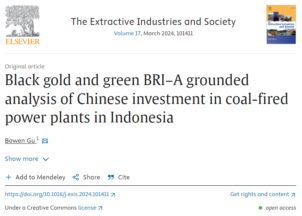
By Bowen Gu
Highlights
- First countrywide analysis of socio-environmental conflicts over coal-fired power plants with Chinese investment.
- Demonstrates how the politics from below shapes BRI energy infrastructure investment in practice.
- Analyzes the uneven development of CFPPs in Indonesia that affects rural, fishing and indigenous communities.
- Reveals socio-environmental conflicts in the coal-fueled energy transition value chain.
- Calls for environmental justice and “blue justice” in the governance of the BRI.
Abstract
From the “Going Out” strategy in the 2000s to the Belt and Road Initiative (BRI) launched in 2013, China has increased its overseas investment and extended the coal value chain beyond its border. Despite China’s commitment of greening the BRI and phasing out overseas coal investment, the socio-environmental impacts of the projects that are already planned, under construction, or in operation are expected to remain. This has led to resistances from local communities and civil society in BRI countries such as Indonesia, the top recipient of Chinese coal financing. Based on a systematic mapping of 25 socio-environmental conflicts over coal-fired power plants (CFPPs), this paper presents a grounded comparative political ecology analysis of Chinese engagement in three types of CFPP projects in Indonesia. The paper addresses the lasting environmental, health and socio-economic impacts of CFPPs that are inextricably intertwined with extractive industries, including coal and nickel. It also discusses the power relations that have shaped socio-environmental conflict dynamics. The paper sheds light on policy recommendations for BRI governance from an environmental justice perspective. It reinforces the call for a research agenda on the BRI that considers not only the China-side perspective, but also the local socio-political dynamics, including the politics from below, that shapes the vision and frictions of a “Green Belt and Road”.
Read the full article here.

The project ENVJUSTICE has received funding from the European Research Council (ERC) under the European Union’s Horizon 2020 research and innovation programme (grant agreement No. 695446)